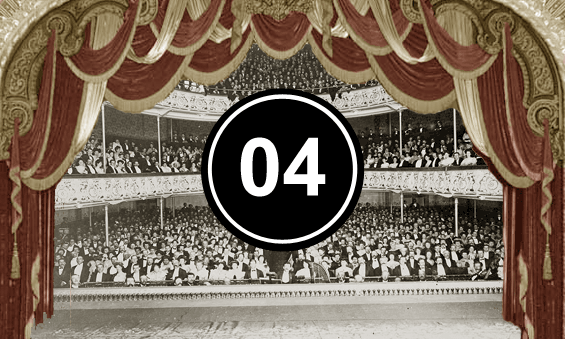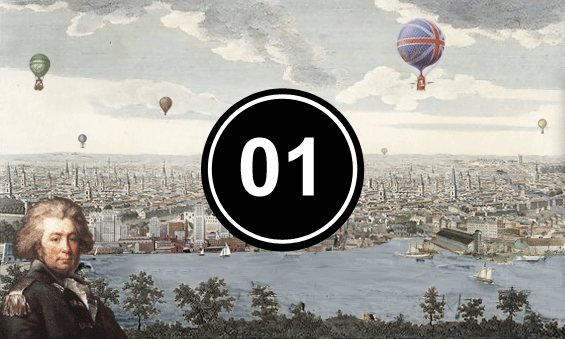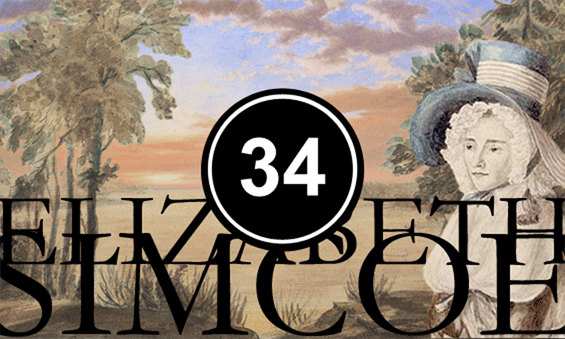This is a photo of horse shit. But it's not just any photo of horse shit. This horse shit is on Woodbury Common — a beautiful patch of heathland in the English countryside. And with horse shit on Woodbury Common, you can tell a story about the founder of Toronto — John Graves Simcoe — and about a man who challenged him to a duel over that dung.
This was a few years after Simcoe founded Toronto. He'd come back home to England by then, returning to his country in a deeply troubled time. England was at war with France.
The French Revolution had started many years earlier; it was already well underway by the time Simcoe and his family left home for Canada. But things had gotten even bloodier while they were gone: Simcoe founded Toronto in July of 1793;
the Reign of Terror began just a couple of months after that, while the Simcoes were living in a pair of fancy tents pitched at the mouth of Garrison Creek.
And even there — six thousand kilometers from the guillotines of Paris — news of the atrocities reached them. In August, the Simcoes were visited by a pair of fleeing French aristocrats hoping
to settle in Upper Canada. They told a morbid story about King
Louis' botched attempt to escape his captors. By the time they shared that anecdote, the French king had already lost his head.
A few months later, Marie Antoinette followed her husband to the guillotine. News of her death took many weeks to travel across the Atlantic
and up the St. Lawrence to the Canadian frontier. When it did, Simcoe marked the occasion with solemn respect. That evening, the settlers of Toronto dressed all in black, postponing the dance they had planned for the night. They might hate the French, but they were staunch monarchists — many of them had already
suffered through the horrors of the American Revolution and were deeply upset by the idea of yet another bloody, democratic uprising.
It was a frightening time. The French Revolution sparked decades of war between France and the monarchies of Europe, including Britain. At the very same time that Simcoe was busy planning the first few blocks of Toronto, he was also busy worrying that the war back home would spread to North America. Even now, French revolutionaries were stirring up trouble in the United States, trying to get the Americans to join the war and invade Canada. Some had even travelled into Québec, where they hoped to convince the French Canadians to rise up and launch their own revolution. As the Simcoes slept in their tents at night, they worried that at any moment an enemy ship might sail over the horizon — or enemy soldiers burst from the woods. Simcoe's wife, Elizabeth, had
nightmares about it.
 |
| John Graves Simcoe |
Things only got scarier when they began to head home for England. As the Simcoes sailed out of the mouth of the St. Lawrence River, French warships were waiting. They chased them out into the Atlantic, seizing other English vessels who were sailing nearby. As the Simcoes' ship dodged icebergs off the coast of Labrador, Elizabeth and the children hid themselves in the cramped quarters below deck. They could hear guns in the distance. It took weeks to sail across the open ocean before the Simcoes finally reached the safety of home.
Even then, it wasn't over. The British would be at war with the French for most of the next twenty years. And things would only get worse. By the time the Simcoes got back to England, a new French general had begun to make a name for himself. Napoleon Bonaparte would prove to be one of the most brilliant and most power hungry dictators in history.
The wars against the French would dominate the rest of Simcoe's life. In the end, he would die fighting them.
But first, he had an important role to play. Simcoe didn't always get along with his superiors, but he did earn the respect of some of the most powerful men in England:
Prime Minister Addington,
Admiral Nelson,
the Duke of York; he even spent time with
"Mad" King George. His experience was especially respected when it came to military matters. He'd been one of the most celebrated heroes on the British side of the American Revolution. And as the first Lieutenant Governor of Upper Canada, he'd been responsible for preparing the defences of the new province in case of an American invasion. And so, just a couple of years after his return to England, Simcoe was given a new job: preparing part of England in case of a French invasion.
At times, it seemed as if that invasion could happen at any moment — especially once Napoleon was in charge. Having already expanded his empire on the Continent, the French general began to assemble an army
to bring England to its knees. Two hundred thousand men were being trained on the coast of France: the Armée d'Angleterre.
A whole flotilla of barges was built to carry them across the English Channel. For a while, Napoleon was even toying with the idea of deploying the world's first air force: a fleet of hot air balloons to support the attack. There were rumours of a giant tunnel being dug beneath the Channel. And of a massive raft powered by windmills. To pay for it all, Napoleon had already sold the Louisiana Territory to the Americans. He was so sure his invasion was going to succeed that he built a triumphal arch to commemorate it before it had even happened.
Meanwhile, on the other side of the Channel, Simcoe was getting ready for the invasion. The British government had put him in charge of the entire defence of the West Country. Devon, Cornwall and Somerset would be under his command. If the French landed there, Simcoe and his men would answer with a scorched earth campaign. They would evacuate all women and children, the elderly and the sick — and all the livestock, too. Everything they left behind would be destroyed. The French would find nothing to eat.
Instead, they would be met by the biggest military force Britain had ever assembled. More than six hundred thousand men were ready to fight — nearly 10% of the entire population of England. In the West Country alone, Simcoe was in command of twelve thousand men.
 |
| Woodbury Common |
But they weren't all experienced soldiers. Professional troops were joined by volunteers and conscripted militia. They needed lots of training. And to do that training, Simcoe sometimes took them to Woodbury Common.
Woodbury Common is high in the gorgeous green hills of Devon. It's just a few kilometers from
the Simcoes' summer home in the seaside town of Budleigh Salterton. And it's not too far from
their country estate in the Blackdown Hills, either. It's a beautiful place: gently rolling hills covered with flowers, shrubs and short grass. It's typical heathland; in fact, if you look up
"heath" on Wikipedia, the first photo you'll see is a photo of Woodbury Common. It's one of England's official Areas of Outstanding Natural Beauty.
At the very highest point on the Common, you'll find a patch of trees. They're growing on the remains of massive earthworks. The big ditches are what's left of the ancient
Woodbury Castle: an Iron Age hill fort built in the days of the druids; it's more than two thousand years old. From the lands around the castle, you can see for miles and miles in every direction — all the way back down to the sea. It's the perfect spot for a military base. In fact, the British army still trains there to this day.
And so about two hundred years ago, you could find thousands of Simcoe's troops camping on Woodbury Common as they awaited Napoleon's arrival — and with those camping men came hundreds of horses.
That, finally, bring us to the horse shit.
With all those horses trotting around, there was, of course, plenty of dung on Woodbury Common. And the question of who was ultimately responsible for it — Simcoe's troops or the local land owner — sparked a fight that nearly ended in a duel. But not for the reason you might think.
The principal owner of the lands around Woodbury Common was a man by the name of
Lord Rolle. History would eventually remember him as the man who
tripped during Queen Victoria's coronation and rolled down the steps to the throne. He and Simcoe didn't get along at all. Rolle was pretty pissed off by the inconvenience caused by all the men camping on the Common. And he was even more pissed off by the fact that they were cleaning up after themselves. Simcoe was making sure that all the horse shit was being collected and taken away. Rolle was furious. He wanted that horse shit for himself. It was valuable manure.
Rolle began a letter-writing campaign. He complained to the authorities, insisting that tradition dictated that any horse shit left by the military on common land belonged to the local lord of the manor: him. Simcoe was stealing his shit. And if Simcoe got away with it, it would set a dangerous precedent: any British general would be allowed to trample the rights of any lord. The question of the horse shit on Woodbury Common, Rolle argued, was a question of importance to every single subject in the British Empire.
Simcoe, for his part, sent a flurry of his own letters arguing the opposite. And as the letters flew back and forth, the fight escalated. Before long, Rolle was ordering his men to physically stop Simcoe's troops from removing the shit from the Common. The dispute was getting so serious that it was eventually forwarded all the way to the man in charge of the entire British military: the Duke of York (the son of "Mad" King George III and
the guy who Simcoe had originally named Toronto after — back when it was still known as the town of York).
 |
| Woodbury Castle |
In the end, Simcoe lost the battle of the Woodbury Common horse shit. His orders came directly from Whitehall — the heart of the British government at Westminster. The manure belonged to Rolle. He would be compensated for the shit that had already been taken away. And he would be allowed to keep any dung produced by Simcoe's horses in the future — as long as he sold it to the public at an appropriate discount.
But Rolle still wasn't satisfied. He was so angry with Simcoe that he challenged him to a duel. He wanted, he declared, to have a fist-fight with the founder of Toronto.
Simcoe was not impressed. Gentlemen, he replied, didn't fight with their fists. It was unseemly. If Rolle wanted to have a duel, they could have a duel: with pistols or with swords. It didn't count if there was no chance you might die.
Rolle backed down.
And so did Napoleon. The tiny French Emperor never did invade England. Instead, he marched his army east into the heart of Europe. But it wasn't the end of Simcoe's connection to the man. There was one sad chapter left to come.
It didn't take long for the French army to invade Spain and Portugal. The Peninsular War — as it was called — would rage for years on end. It was a bloody campaign. Tens of thousands were killed or wounded. Simcoe's own son, Francis, would die during
the Siege of Badajoz in Portugal. (Just a toddler when Toronto was founded, his parents had jokingly named their log cabin in his honour: Castle Frank. We still remember it today in the name of a subway station.)
By then, John Graves Simcoe was already dead. He died during that same campaign. His preparations for Napoleon's invasion had earned him a promotion:
Commander-in-Chief of the entire British army in India. But just before he left for his new post, he got new orders: his services were once again desperately needed in the fight against the French. Simcoe sailed to Portugal. But the ship he sailed on was damp and newly painted. He had always suffered from terrible respiratory problems — in fact, that's why he'd been forced to come home from Canada.
Simcoe was deathly ill by the time he made it to Lisbon. He would never recover. He was loaded back onto the same sickly ship and sent home across the Channel to England. He died in Exeter just a few days later.
As for Napoleon, well, he did finally make it to Devon one day. But it wasn't at the head of an invading army. Instead, he saw those rolling green hills from the deck of a British ship as it sailed by. It was all over; he'd lost the Battle of Waterloo and was now being held prisoner. Defeated for the final time, the French general asked if he could retire in England with a small parcel of land. His request was refused. The British didn't let him off that ship; he was never to set foot in Devon. Instead, they kept sailing, taking him far away to the isolated island of Saint Helena where he would live out the rest of his days in peace and frustrating quiet.
-----
More than two hundred years after Simcoe founded our city, Toronto is still wrestling with the question of who is responsible for our horse shit. You can read more about that on the CBC News website here.
The first person to alert me to the story of Simcoe and the shit was Michael Downes at the Fairlynch Museum in Budleigh Salterton. You can find the museum at their website, on Twitter, and on Facebook.
Simcoe's biographers, Mary Beacock Fryer and Christopher Dracott, cover the story in their book, which you borrow from the Toronto Public Library here or buy here.
You can learn more about Napoleon's brief stay in Devon in Devonshire Magazine here.
Photos of Woodbury Common and Woodbury Castle by me: Adam Bunch.
| This post is related to dream
01 Metropolitan York
John Graves Simcoe, 1793 |
| This post is related to dream
30 The Conference of the Beasts
Francis Simcoe, 1796 |
| This post is related to dream
34 The Upper Canadian Ball
Elizabeth Simcoe, 1793 |





















